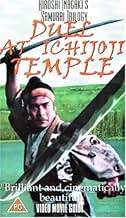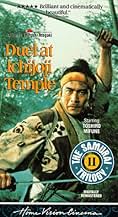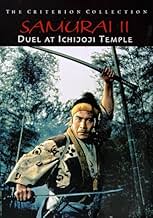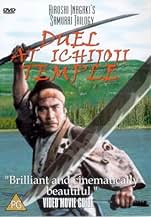ÉVALUATION IMDb
7,3/10
7,1 k
MA NOTE
Ajouter une intrigue dans votre langueMusashi Miyamoto returns to Kyoto after years of absence. After a series of fights against the Yoshioka School, he challenges its master to a duel.Musashi Miyamoto returns to Kyoto after years of absence. After a series of fights against the Yoshioka School, he challenges its master to a duel.Musashi Miyamoto returns to Kyoto after years of absence. After a series of fights against the Yoshioka School, he challenges its master to a duel.
Histoire
Le saviez-vous
- AnecdotesIn a scene in which Musashi is staying in a courtesan's compound to avoid his antagonists, he is seen painting in ink. In reality, Musashi was an artist and actually did create many works of art, such as one titled "Shrike in a barren tree", and they still exist to this day in museums throughout Japan.
- GaffesMany of the guys killed in swordplay go down with either no visible contact between their bodies and a katana, or appear to be hit in the arm or leg with a non-fatal slash that stills ends them, regardless.
- Citations
Musashi Miyamoto (Takezo): I renounce my love of women.
- ConnexionsFeatured in Miyamoto Musashi kanketsuhen: kettô Ganryûjima (1956)
Commentaire en vedette
Samurai II: Duel at Ichijoji Temple is the second part of the so-called Samurai trilogy by Inagaki Hiroshi about legendary historical figure Miyamoto Musashi who was a highly accomplished samurai who wasn't only a great fighter but also an intellectual philosopher and a skilled artist. This movie shows how a young ronin travels the country for enlightenment and training for several years to become an accomplished samurai.
The main plot of the movie focuses on Miyamoto Musashi challenging a martial arts school. He also meets respectable opponent Sasaki Kojiro who he will eventually fight in the last film. His relationship with Otsu is further explored as she patiently waits for his destiny to be fulfilled.
In comparison to the first movie, this sequel has more fight scenes that are quite dynamic, epic and tense. The movie starts with an impressive duel and ends with a fight between Miyamoto Musashi on one side and eighty martial arts school students on the other side. The film has an overall quicker pace than the first part and is thoroughly entertaining.
All beloved characters from the first movie are back in the sequel and Mifune Toshiro's acting skills are once again quite impressive even though he seems to be acting too impulsively at times to portray a character who has undergone changes to find peace of mind. Mifune Toshiro fits the role much better in the energetic first film and accomplished third movie of the trilogy.
The main reason why this movie is the weakest part of the trilogy is because it skips three years in the life of Miyamoto Musashi and fails to tell how the protagonist has changed. This is even more inappropriate regarding the side characters. The last time we saw the protagonist's childhood friend Matahachi, he was engaged to Otsu but had parted with beautiful Akemi and her manipulative mother Oko to protect them against bandits. Three years later, he has suddenly married Oko who is though having a romantic relationship with Toji who works for a wealthy martial arts school owner whom he expects to marry Akemi and hopes to make lots of money in the process. It's never explained how Oko and Matahachi got married, how their relationship failed and how Toji met the unstable trio.
Despite a few plot holes and some lack of character development, it's essential to watch Samurai II: Duel at Ichijoji Temple as a link between the energetic first film and the accomplished third movie. This second part is still entertaining with its wonderful cinematography, improved fight scenes and plot filled with sinister intrigues. Don't jump on the tiring Game of Thrones bandwagon and watch this movie instead which offers similar contents with more style.
The main plot of the movie focuses on Miyamoto Musashi challenging a martial arts school. He also meets respectable opponent Sasaki Kojiro who he will eventually fight in the last film. His relationship with Otsu is further explored as she patiently waits for his destiny to be fulfilled.
In comparison to the first movie, this sequel has more fight scenes that are quite dynamic, epic and tense. The movie starts with an impressive duel and ends with a fight between Miyamoto Musashi on one side and eighty martial arts school students on the other side. The film has an overall quicker pace than the first part and is thoroughly entertaining.
All beloved characters from the first movie are back in the sequel and Mifune Toshiro's acting skills are once again quite impressive even though he seems to be acting too impulsively at times to portray a character who has undergone changes to find peace of mind. Mifune Toshiro fits the role much better in the energetic first film and accomplished third movie of the trilogy.
The main reason why this movie is the weakest part of the trilogy is because it skips three years in the life of Miyamoto Musashi and fails to tell how the protagonist has changed. This is even more inappropriate regarding the side characters. The last time we saw the protagonist's childhood friend Matahachi, he was engaged to Otsu but had parted with beautiful Akemi and her manipulative mother Oko to protect them against bandits. Three years later, he has suddenly married Oko who is though having a romantic relationship with Toji who works for a wealthy martial arts school owner whom he expects to marry Akemi and hopes to make lots of money in the process. It's never explained how Oko and Matahachi got married, how their relationship failed and how Toji met the unstable trio.
Despite a few plot holes and some lack of character development, it's essential to watch Samurai II: Duel at Ichijoji Temple as a link between the energetic first film and the accomplished third movie. This second part is still entertaining with its wonderful cinematography, improved fight scenes and plot filled with sinister intrigues. Don't jump on the tiring Game of Thrones bandwagon and watch this movie instead which offers similar contents with more style.
- kluseba
- 29 avr. 2019
- Lien permanent
Meilleurs choix
Connectez-vous pour évaluer et surveiller les recommandations personnalisées
- How long is Samurai II: Duel at Ichijoji Temple?Propulsé par Alexa
Détails
- Date de sortie
- Pays d’origine
- Langue
- Aussi connu sous le nom de
- Samurai II: Duel at Ichijoji Temple
- Lieux de tournage
- société de production
- Consultez plus de crédits d'entreprise sur IMDbPro
- Durée1 heure 44 minutes
- Mixage
- Rapport de forme
- 1.37 : 1
Contribuer à cette page
Suggérer une modification ou ajouter du contenu manquant

Lacune principale
By what name was Zoku Miyamoto Musashi: Ichijôji no kettô (1955) officially released in India in English?
Répondre































